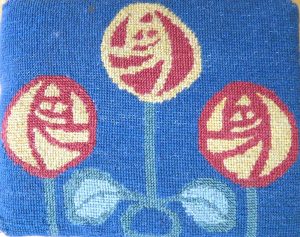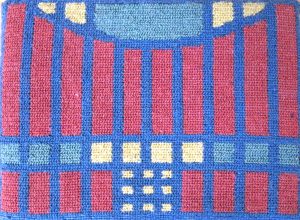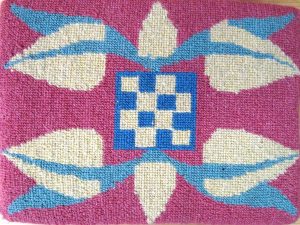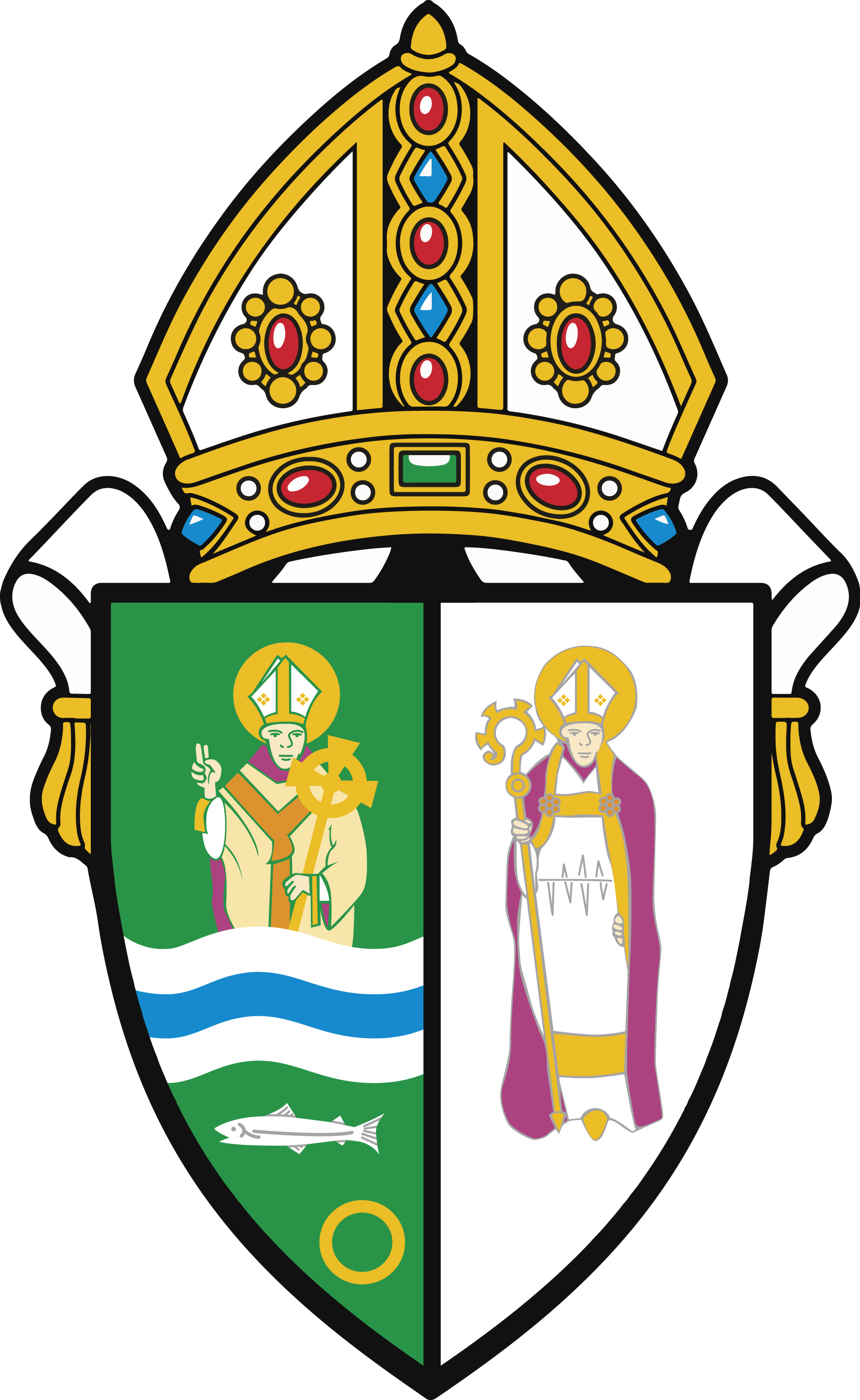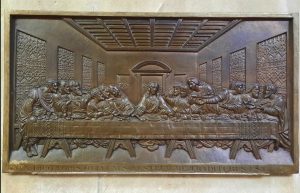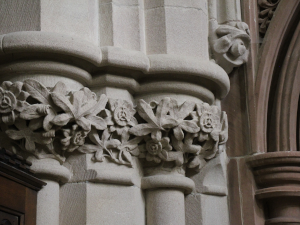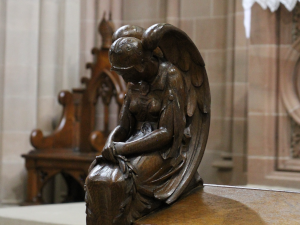This beautiful building has been a place for Christian worship since it was built in 1873 to the design of the eminent Scottish architect Sir Robert Rowand Anderson.
Main doors
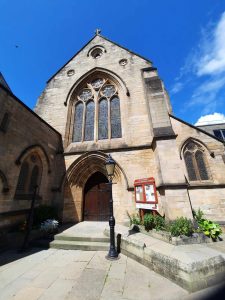
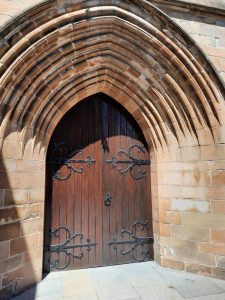
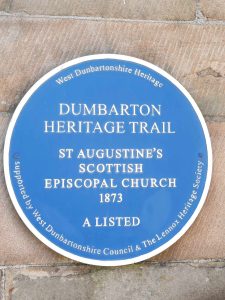
These doors are very much in the Gothic Revival style. They are made of oak and have very heavy iron hinges and locks and are set in a pointed arch.
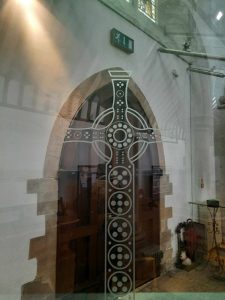
Since the building of the new porch (designed by Richmond Architects, Dumbarton) in 2003, it is possible to view the church even when it is not open. The Celtic cross design on the glass is based on that in St Michael and All Angels Scottish Episcopal Church, Helensburgh, another church designed by Anderson.
Now go clockwise round the church and enjoy its various features.
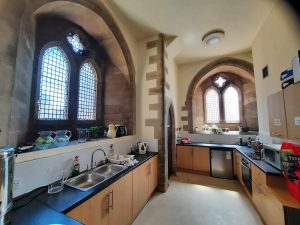
The door on your left leads to a small kitchen and toilet. Originally this area was designed to have a spire above it. Although the thick walls were built to carry the weight, the builder went bankrupt, and the church then couldn’t afford to build the spire.
Baptismal Font
The font is a very large bowl, which is used to hold the holy water used at a baptism. As in many churches the font at St Augustine’s is near the front door. It is carved from stone and on the side of it can be seen several animals and other symbols.
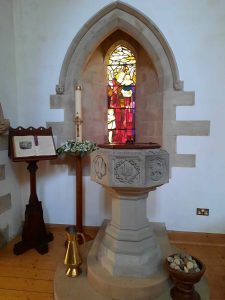
The lamb represents Christ the Redeemer, ‘the Lamb of God who takes away the sins of the world’ (John 1: 29). The fish was used as a symbol of Christ in the early Christian Church. The dove, as well as symbolising the Holy Spirit in Christian art is used to represent peace, tenderness, and innocence. Like many others its octagonal shape is also symbolic, the eight sides representing resurrection and new life.
In very old churches the font did not have a cover, but in 1236 they started to be covered and locked so that superstitious people could not steal the holy water!
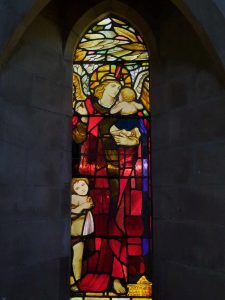
Adam Window
Behind the font is a particularly fine stained-glass window. It was given to the church in 1897 by the children of the Sunday School and is titled ‘Suffer the Little Children’. It is a fine example of the work of Stephen Adam of Glasgow (1848 – 1910).
Return to the centre aisle and look up and admire the
Scissor Beam/Truss Roof
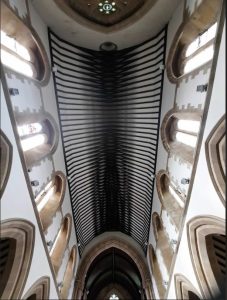
It gets its name from being shaped like an opened pair of scissors. Scissors trusses are used almost entirely in building construction to support a pitched roof, where internally a sloping or raised ceiling surface is desired to give height to the middle of the space. Robert Rowand Anderson designed several churches with this feature.
Walk down the aisle and you will see on your left hand side
The War Memorial
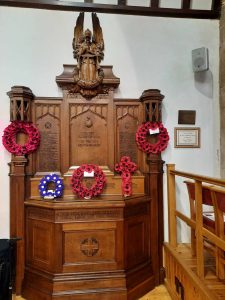
Carved in oak and installed in the early 1920s ‘to preserve the names of the Congregation who made the supreme sacrifice in the Great War’, it had to be extended to record the names of those who died in World War II. It was designed (for free) by R.M.McNaught, ARIBA, of Messrs Denny and Blain.
The Brass Plaque to the right is from St Columba’s SEC Clydebank and is based on Leonardo Da Vinci’s painting “The Last Supper”.
Prayer Chapel
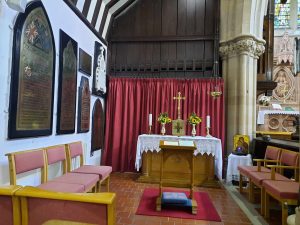
Here you are welcome to stop and spend some time in prayer and reflection before the Blessed Sacrament.
You can see some of the Memorial Plaques that have been placed in the Church over the years, as well as John Woodcock’s carving ODAAT (One Day at a Time) a memorial to those who have died from addiction, and a lovely Icon of the Blessed Virgin Mary. You are welcome to light a candle and stay for a while.
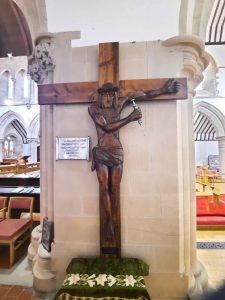
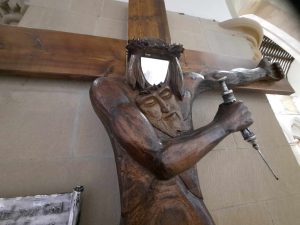
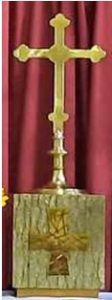
The Tabernacle can be seen in this area. It is used to store the Reserved Sacrament (consecrated bread and wine) which is taken to the sick and housebound and is distributed occasionally at Services where no Priest is present to preside.
The Sanctuary Lamp hangs by the altar in the prayer chapel.
By tradition it gives out a red light. To achieve this, we burn a long-life candle that gets replaced weekly.
Now return to the centre aisle and look up towards the Altar.
The Window over the Altar (The Te Deum Window)
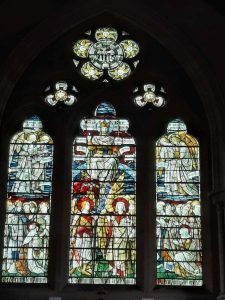 This window is a fine example of work carried out by the McCulloch and Gow Studios of Glasgow (1874 – 1891) to a design by the artist Vincent Hart. Hart, although based in London operated as a freelance artist for many studios throughout the country. His design is based on the Te Deum, a great hymn of praise in the Western Church and part of the daily service of Morning Prayer found in The Scottish Prayer Book.
This window is a fine example of work carried out by the McCulloch and Gow Studios of Glasgow (1874 – 1891) to a design by the artist Vincent Hart. Hart, although based in London operated as a freelance artist for many studios throughout the country. His design is based on the Te Deum, a great hymn of praise in the Western Church and part of the daily service of Morning Prayer found in The Scottish Prayer Book.
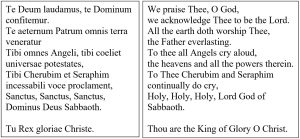
As well as portraying Christ the King, angels, cherubim and seraphim, the window also depicts significant saints. On the left side you can see (left to right) Saints Columba, Kentigern (Mungo) (spot the robin), Andrew, Patrick with St Margaret kneeling. To the right are Saints John the Baptist, Augustine, John the Evangelist, and Ambrose. The kneeling woman could be St Monica, mother of St Augustine of Hippo, our Patronal Saint.
Walking towards the steps you will see from left to right the Pulpit, the Nave Altar, and the Lectern.
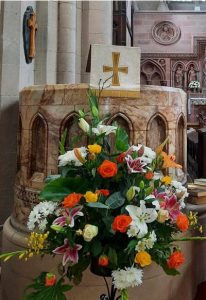
Pulpits were important before the introduction of sound systems. They enabled the preacher to be higher than the congregation so that sermons could be heard more easily.
The pulpit in St Augustine’s is made of marble.
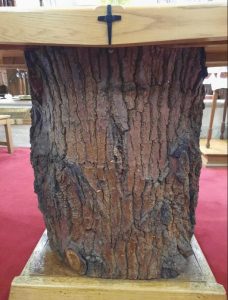
The Nave Altar, crafted for the Church by Sean Hoey (Helensburgh, 2003), is based on the design from a Church in Tanji, The Gambia. The tree trunk represents the Tree of Life and reminds us that Jesus is the vine and we are the branches. At each Eucharist Service we are nourished by the True Vine.
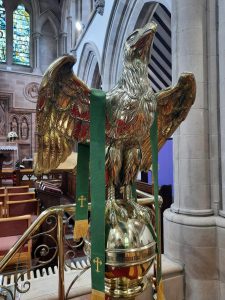
The large brass eagle Lectern was donated by Mr George Brown in memory of his sister. The eagle has outstretched wings and stands on a ball.
The ball represents the world whilst the Bible on the bird’s back symbolises the Gospel being carried on wings to the corners of the earth.
Now go past the nave altar and enter the Sanctuary. In front of you can be seen the
Altar or Communion Rail
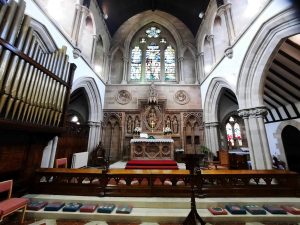
This low oak rail was added to the church in the early 1920s in memory of those who died in the war. The carvings are reputed to be of two of the Angels of Mons (who were said to have appeared over the Battle of Mons in 1914). Here members of the congregation kneel when they receive Holy Communion from this altar.
(Communion rails were widely introduced in the time of Elizabeth I of England to stop access to the altar by dogs!)
High Altar and Reredos
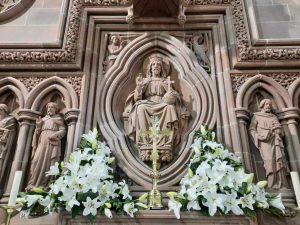 Made of sandstone, the front is a carved panel and there is a particularly fine reredos, also of carved red sandstone, enriching the wall behind. It was designed by Robert Rowand Anderson and was donated by Major R.E.Findlay and his two brothers in memory of their parents. Its beautiful red colour only become apparent after it was cleaned in the mid 1990s. Like many others, the reredos here has carved figures, including the four Evangelists (Matthew, Mark, Luke, and John). In the centre is Christ the King surrounded by biblical animals and beasts.
Made of sandstone, the front is a carved panel and there is a particularly fine reredos, also of carved red sandstone, enriching the wall behind. It was designed by Robert Rowand Anderson and was donated by Major R.E.Findlay and his two brothers in memory of their parents. Its beautiful red colour only become apparent after it was cleaned in the mid 1990s. Like many others, the reredos here has carved figures, including the four Evangelists (Matthew, Mark, Luke, and John). In the centre is Christ the King surrounded by biblical animals and beasts.
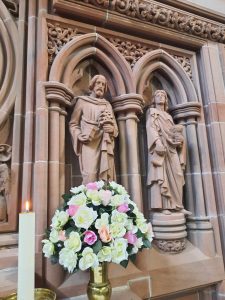
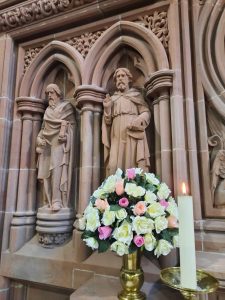
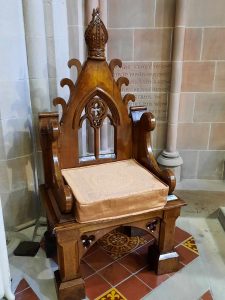
Beside the altar you can see the ornate Gothic-style oak Bishop’s Chair with trefoil designs, a pattern of three interlocking circles used as a symbol in church architecture to represent the Holy Trinity (Father, Son, and Holy Spirit). These three overlapping rings depict the interconnected and inseparable nature of God.
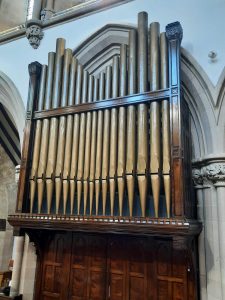
On your left is the Organ that was installed in 1880. It is the sole surviving example of the work of the short-lived partnership of Spring and Brook of Glasgow (1879 – ca 1881). The casework was designed by the church’s architect, Robert Rowand Anderson. Although robustly built, with high quality pipework and an unusual action, the organ is not in good condition at present, and it is hoped that in the future we may be able to undertake its restoration.
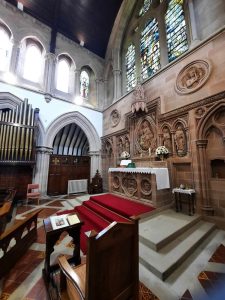
Behind the Organ is the Vestry, a small room designed to hold the Priest’s vestments (or robes) and in which the Clergy prepare themselves in prayer before taking a Service. Here the Holy Oils are kept for Baptisms, Confirmations, and Anointing of the sick.
You can now leave the altar area by turning right towards the side door
Window by Side Door
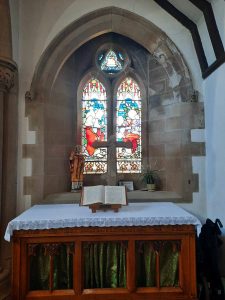
This window is an example of the work by W.J.J. Kier of Glasgow, 1830 – 1908. It is in very poor condition due to the use of borax in the painting process, a technique used by many studios at the time because it speeded up the firing process. Unfortunately, borax remains water-soluble and has slowly disappeared.
The Side Altar under this window was gifted in 1999 by Faslane Naval Base, after two Chapels were amalgamated.
On this altar you will see the Stone Cross that was removed
from the apex of the Church roof during the restoration in 2003. It had stood overlooking the Church and the High Street for 130 years and is rather weather-beaten! There is also a small statue of St Mungo, a remnant of St Mungo’s Scottish Episcopal Church, Alexandria, which closed in 2021.
Now look up and towards the centre of the church to
the High Window where you can see St Peter, the only one of the apostles to have found a place in the 12 windows reserved for them.
Window at end of the South Aisle
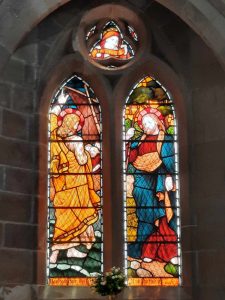
Like the next window this pair of windows were produced by the workshops of Shrigley and Hunt of Lancaster, to designs by the artist Carl Alnquist (1848 – 1924). It was given to the Church in memory of George Francis Frizell (from County Wicklow), the brother-in-law of Peter Denny, who died in an accident in Shanghai. It depicts two images of Jesus: walking on the water whilst reassuring his disciples “Be of good cheer, it is I” (Matt 14: 27) and as the shepherd seeking the lost sheep “until he find it” (Luke 15: 4).
As you return to the centre aisle look up and admire the windows over main door
The West Window (The Saints Window)
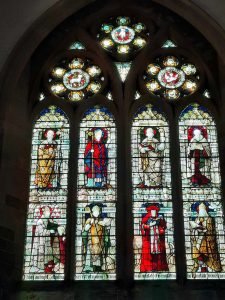
Perhaps the most striking of all, this window portrays eight Saints. Four are Scottish Saints (upper, left to right: St Ninian, St Patrick, St Kentigern (Mungo), and St Columba). The other four are Doctors of the Church (lower, left to right: St Augustine of Hippo, St Ambrose, St Hieronymus (Jerome), and St Gregory) who were early Christian Fathers whose theological thinking and writing are particularly important, even today.
Built 1873 Restored to the Glory of God and for God’s people 2003.
The Charles Rennie Mackintosh connection.
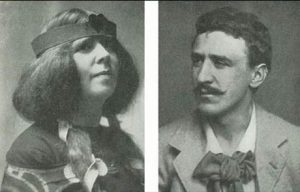 On 22nd August 1900 Charles Rennie Mackintosh (bachelor age 32, architect, 120 Main Street, Glasgow) married Margaret MacDonald (spinster age 35).
On 22nd August 1900 Charles Rennie Mackintosh (bachelor age 32, architect, 120 Main Street, Glasgow) married Margaret MacDonald (spinster age 35).
On 14th June of the previous year James Herbert McNair (bachelor, age 30, Lecturer in Applied Arts, Liverpool) married Frances Eliza MacDonald (spinster, age 25).
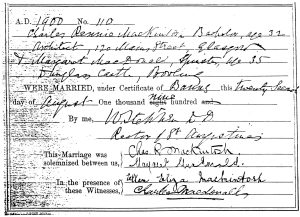
Both marriages took place in St Augustine’s Church, by the Rector, Rev. Dr W Stephenson DD. A witness for both weddings was Frances and Margaret’s brother Charles MacDonald.
The residence of both brides was Dunglass Castle, Bowling, the home of their brother Charles.
